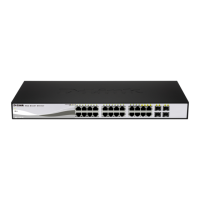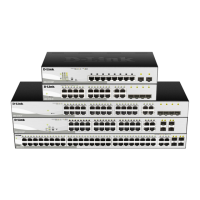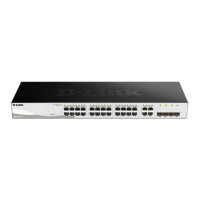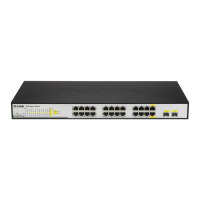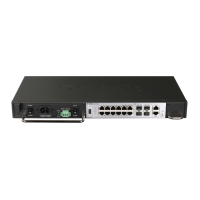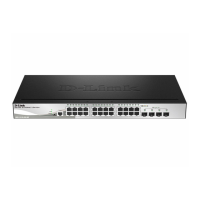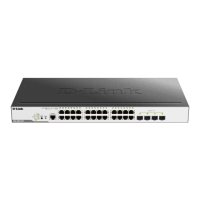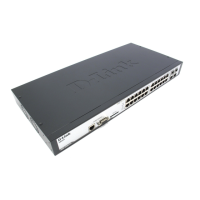Do you have a question about the D-Link DGS-1210-10/ME and is the answer not in the manual?
Overview of the DGS-1210/ME Metro Ethernet Switch's capabilities and features.
Details components and indicators on the front panel of the switch models.
Details the process of unpacking the switch and checking its contents.
Provides instructions for installing the switch in desktop or rack-mount configurations.
Guide on how to connect the AC power cord to the switch and an electrical outlet.
Explains how to access and use the switch's web-based management interface.
Details the web-based management interface areas: Tool Bar, Function Tree, and Main Configuration Screen.
Covers saving configuration and log files through the Tool Bar's Save Menu.
Explains global functions like reset, reboot, backup, and firmware upgrade from the Tool Menu.
Allows configuration of IP address and basic system information for the switch.
Displays firmware details and allows specifying configuration/image files for boot-up.
Enables adjustment of Baud Rate and Auto Logout settings for the console port.
Allows configuration of IPv6 system settings and IP interface details.
Allows configuration of IPv6 system information and settings.
Monitors and adjusts port status, speed, and duplex settings for optimum configuration.
Enables or disables the SNMP function globally on the switch for network management.
Maintains the SNMP user table for SNMPv3, allowing user access control and message encryption.
Associates users with SNMP group tables to control MIB access and security policies.
Configures SNMP trap recipients for receiving notifications from the switch.
Allows control of user privileges, adding, modifying, and deleting user accounts.
Enables or disables the web-based management interface for switch configuration.
Enables or disables the Telnet service for remote management of the switch.
Enables or disables the password encryption state for enhanced security.
Manages system logs, reports errors, and configures remote system log servers.
Configures up to four designated servers for sending Syslog messages.
Reduces power consumption automatically when ports are idle or devices are turned off.
Configures SMTP server settings for sending email notifications and log files from the switch.
Enables Jumbo Frame support to enhance Ethernet networking throughput and reduce CPU utilization.
Provides VLAN management functions for organizing ports into broadcast domains.
Allows configuration of Private VLAN settings, including isolated and community VLAN types.
Creates MAC-based VLAN entries to map MAC addresses to existing static VLANs.
Enables or disables the Q-in-Q function for service providers to carry traffic from multiple users.
Combines two or more ports to increase bandwidth and creates Trunk groups.
Sets ports to be active or passive in processing and sending LACP control frames.
Enables IGMP snooping for intelligent multicast forwarding decisions.
Monitors network traffic by forwarding copies of incoming/outgoing packets to another port.
Configures time settings for the switch to synchronize with an SNTP server or local time.
Enables and configures global settings for DHCP/BOOTP Relay services on the switch.
Configures global settings for Spanning Tree Protocol versions like STP, RSTP, and MSTP.
Configures Spanning Tree parameters on a per-port or per-group basis.
Configures Ethernet OAM settings for ports, enabling Active or Passive modes.
Configures actions for ports when exceeding alarm or warning thresholds for SFP modules.
Provides ability to control receive rate of broadcast, multicast, and unknown unicast packets.
Defines bandwidth settings for a specified port's transmitting and receiving data rates.
Manages switch access from remote stations by defining IP addresses/Subnet Masks.
Automatically throttles packet flooding to protect the switch CPU from malicious attacks.
Prevents unauthorized computers by controlling MAC address learning and port access.
Provides secure communication path for Web Management and Switch Web UI using encryption.
Restricts client access by enabling configuration of allowed IP-MAC address pairs.
Allows creation of static IP-MAC-Port Binding entries on the switch.
Displays IP-MAC-Port Binding entries; only matching information allows switch access.
Provides network access control using IEEE 802.1X, requiring authentication for port access.
Facilitates centralized user administration and protection against hackers using RADIUS.
Disables auto-learning for uplink ports and specifies static MAC addresses for security.
Displays the switch's dynamic MAC address forwarding table.
Enables administrator-defined authentication policies for users accessing the switch.
Groups TACACS+ and RADIUS server hosts into user-defined categories for authentication.
Sets user-defined Authentication Server Hosts for TACACS+ and RADIUS security protocols.
Allows secure remote login and network services over an insecure network using SSH.
Configures MAC-based Access Control settings, including authentication methods.
Sets a list of MAC addresses and their target VLAN for switch authentication.
Assists in creating access profiles and ACL rules for packet forwarding criteria.
Displays PoE status, including system budget power and power supply ratio.
Configures Power over Ethernet (PoE) settings for individual ports.
Creates up to 256 static route entries for IPv4 formatted addressing.
Enters static entries of IPv6 addresses into the switch's routing table.
| Product Type | Managed Switch |
|---|---|
| Number of Ports | 10 |
| Layer | Layer 2 |
| Switching Capacity | 20 Gbps |
| Forwarding Rate | 14.88 Mpps |
| MAC Address Table | 8K |
| Power over Ethernet (PoE) | No |
| Dimensions | 440 x 180 x 44 mm |
| Packet Buffer Memory | 1.5 MB |
| VLAN Support | Yes |
| Quality of Service (QoS) | Yes |
| IGMP Snooping | Yes |
| Flow Control | Yes |
| Ports | 8 x 10/100/1000 ports, 2 x SFP ports |
| Jumbo Frame | 9216 bytes |
| Switch Type | Managed |
| Management Type | Web-based, CLI, SNMP |
